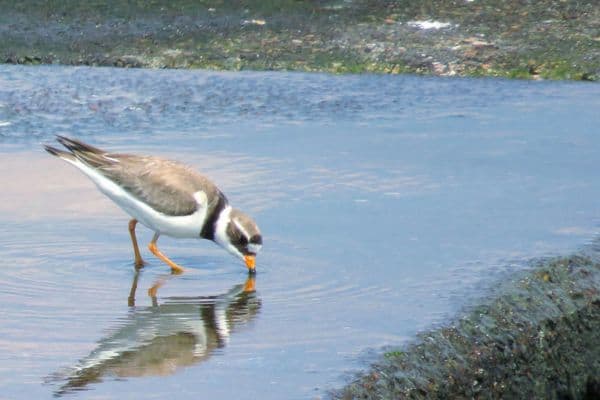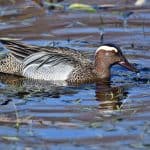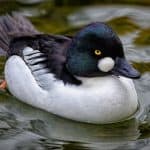Common Name: Common Ringed Plover
Scientific Name: Charadrius hiaticula| Size | Diet | Range in Hawaii | Status in Hawaii |
|---|---|---|---|
| 6 in. - 7 in. | beetles, flies, spiders, worms, crustaceans, and mollusks | Unknown | Least Concern |
The Common Ringed Plover, also known as Charadrius hiaticula, is a small shorebird with a distinctive black band around its neck. This bird is found across the Palearctic, breeding in the Arctic regions of Canada and occasionally in Alaska.
During the winter months, it migrates to southern Europe, Africa, and southern Asia, with occasional sightings in Australia. While it is a common sight in many parts of the world, the Common Ringed Plover is a rare visitor to Hawaii, where it is considered a non-breeding visitor and vagrant.
Despite its rarity in the region, the Common Ringed Plover has managed to capture the interest and fascination of birdwatchers and nature enthusiasts alike. In this article, we will explore the fascinating world of the Common Ringed Plover and its existence in Hawaii.
Common Ringed Plover
Appearance

The Common Ringed Plover is a small shorebird with a distinct appearance. It has a compact and rounded body shape, measuring approximately 6-7 inches (15-18 cm) in length. The adult birds have a brownish-gray upper body with darker wings and a white belly.
They have a prominent black breastband that extends across the upper chest, giving them their “ringed” name. Their face is mostly white, with a black crown and a black line extending from the beak to the eye. Their beak is short and black, and their legs are also black.
In flight, the Common Ringed Plover displays a bold white wing stripe that is visible against the darker wings. Juvenile birds have a duller plumage and lack the distinctive black and white markings of the adults. Overall, the Common Ringed Plover is a small, well-marked shorebird with a striking appearance.
Diet
The diet of the Common Ringed Plover primarily consists of invertebrates, especially small insects and their larvae. They feed on a variety of prey found in their habitats, such as beetles, flies, spiders, worms, crustaceans, and mollusks.
These plovers are known to forage in coastal areas, mudflats, sandy beaches, and shallow waters near shorelines. They have a characteristic feeding behavior, running quickly along the shoreline or probing the wet sand with their bills to locate and capture their prey.
They may also catch insects in mid-air or pick them off vegetation. The Common Ringed Plover is an opportunistic feeder, adapting its diet based on the availability of food resources in its habitat.
Nesting
The Common Ringed Plover nests on the ground in open habitats near water, such as beaches, dunes, marshes, and gravelly areas. The nesting season typically occurs from late spring to early summer. The nest itself is a shallow depression lined with pebbles, shells, or bits of vegetation. The female usually takes the lead in nest construction, while the male assists in gathering nesting materials.
A typical clutch contains about three to four eggs, which are usually creamy or buff-colored with dark speckles or blotches that provide camouflage. Both parents take turns incubating the eggs, which lasts for about 25-28 days. During this period, they display a distraction behavior, feigning injury or limping to divert potential predators away from the nest.
Once the eggs hatch, the precocial chicks are able to leave the nest shortly after birth and start foraging for food with their parents. The parents provide protection and guidance to the chicks, teaching them essential skills for survival. The young plovers fledge, or acquire the ability to fly, at around 28-35 days old.
Behavior

The Common Ringed Plover displays a variety of behaviors that contribute to its survival and successful adaptation to its environment. One notable behavior is its feeding strategy. These plovers are active foragers, commonly observed running along shorelines or sandy beaches.
With swift movements, they probe the sand or peck at the ground in search of their primary food source, which includes small invertebrates like insects, spiders, worms, and crustaceans. They may also snatch insects in mid-air or pick them off vegetation, showcasing their agility and opportunistic feeding behavior.
In terms of nesting behavior, Common Ringed Plovers exhibit unique traits. They construct their nests on the ground in open habitats near water, such as beaches, dunes, marshes, or gravelly areas. The nests are shallow depressions lined with materials like pebbles, shells, or bits of vegetation.
The female takes the lead in nest construction, while the male assists in gathering nesting materials. Both parents share incubation duties, taking turns to keep the eggs warm and safe. They are vigilant and protective, engaging in distraction displays to draw potential predators away from the nest.
When it comes to their interactions with other individuals, Common Ringed Plovers can display territorial behavior during the breeding season. They defend their nesting territories from intruders, engaging in aggressive displays and vocalizations. Outside of the breeding season, they may gather in loose flocks, often with other shorebird species, for foraging or roosting purposes.
During flight, these plovers demonstrate graceful and agile movements. Their wings are pointed, and they have a distinct white wing stripe that becomes evident during flight. They may perform aerial displays, such as courtship flights or territorial defense, involving swooping and calling.
Habitat
The Common Ringed Plover is a bird species that is well-adapted to various coastal and shoreline habitats. It can be found in a range of environments throughout its breeding and wintering ranges.
During the breeding season, it selects open habitats near water, such as sandy beaches, dunes, gravelly areas, marshes, and coastal meadows. These habitats provide suitable nesting grounds with access to nearby foraging areas.
In winter, the Common Ringed Plover migrates to different regions, including southern Europe, Africa, southern Asia, and occasionally Australia. During this time, it occupies a variety of habitats along coastlines, estuaries, mudflats, lagoons, and shallow wetlands.
These areas offer ample food resources, including invertebrates found in the sand, mud, or shallow waters. The species is adaptable to both natural and human-altered coastal environments.
It can be observed in natural coastal habitats, as well as man-made habitats such as salt pans, saltworks, and artificial shorelines. Common Ringed Plovers often show a preference for areas with sandy or gravelly substrates where they can easily forage for prey.
Range
In the Hawaiian Islands, approximately 170 individuals of the Common Ringed Plover and Semipalmated Plover species pair have been recorded. Of these, only three confirmed and five possible Common Ringed Plovers have been documented.
The Northwestern Hawaiian Islands account for five of these records, while the Southeastern Hawaiian Islands have three. Noteworthy sightings include a well-studied individual photographed on Midway from late April to late May 1997. The absence of palmations on the toes and distinctive tracks helped confirm its identification as a Common Ringed Plover.
Several other sightings based on photographs or detailed descriptions in the Northwestern Islands were suggestive but lacked conclusive evidence to confirm the species. Substantiated individuals were also observed on Kaua’i, with first-fall birds photographed at Hanalei NWR and Anini Beach.
Conservation Status

The Common Ringed Plover is listed as a species of Least Concern by the International Union for Conservation of Nature (IUCN). This designation indicates that the species has a large population and is not currently facing any significant threats that would warrant a higher conservation status. The global population of Common Ringed Plovers is believed to be stable, and the species is able to adapt to a range of habitats across its breeding and wintering ranges.
While the Common Ringed Plover may face local conservation challenges in specific regions, such as habitat loss, disturbance, or pollution, these issues have not led to significant population declines on a global scale. Conservation efforts generally focus on the protection and management of important breeding and wintering habitats, as well as raising awareness about the species and promoting responsible coastal management practices.
Interesting Facts
1. Confusion with Semipalmated Plover
The Common Ringed Plover can be easily confused with the similar Semipalmated Plover, making accurate species identification challenging. This confusion has led to difficulties in determining the exact status of the Common Ringed Plover in certain regions, such as the Pacific.
2. Agile foragers
Common Ringed Plovers exhibit agile foraging behavior, often seen running along shorelines, probing the sand, or pecking at the ground to find their prey. They primarily feed on small invertebrates such as insects, spiders, worms, and crustaceans.
3. Protective parents
Both male and female Common Ringed Plovers share incubation duties, taking turns to keep the eggs warm and safe. They are vigilant and will engage in distraction displays to draw potential predators away from the nest.
4. Camouflage adaptation
The plumage of the Common Ringed Plover provides excellent camouflage, allowing it to blend in with its surroundings. This helps protect the bird from potential predators by making it less visible on sandy or gravelly beaches.
Frequently Asked Questions
1. How can the Common Ringed Plover be distinguished from the similar Semipalmated Plover?
Distinguishing between the Common Ringed Plover and the Semipalmated Plover can be challenging. However, one key difference is that the Common Ringed Plover lacks webbing (palmations) between its toes, whereas the Semipalmated Plover has partially webbed feet.
2. How long do Common Ringed Plovers live?
The lifespan of Common Ringed Plovers is not well-documented, but they can live up to 10 years under favorable conditions. Various factors, including predation, habitat quality, and human disturbances, can influence their lifespan.
3. Are Common Ringed Plovers monogamous?
Yes, Common Ringed Plovers are generally monogamous. Mated pairs form during the breeding season and share responsibilities in incubating the eggs and caring for the chicks.
4. Can Common Ringed Plovers swim?
While Common Ringed Plovers are primarily shorebirds adapted to terrestrial habitats, they are capable of swimming if necessary. However, they typically rely on their walking and running abilities for movement.




